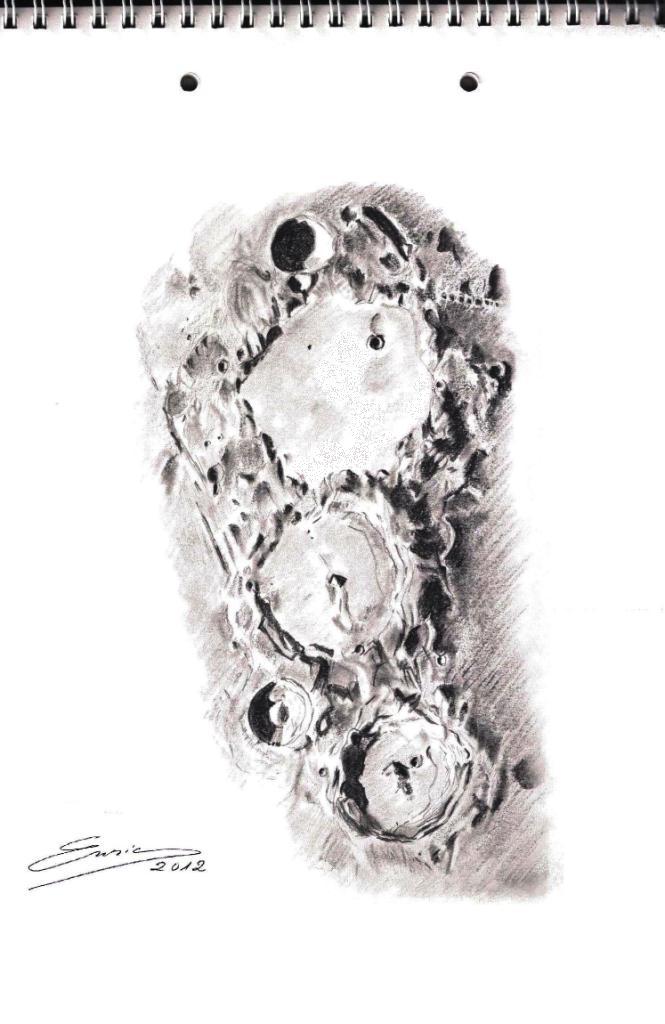
Object Name: Chain of lunar craters Ptolemaeus, Alphonsus & Arzachel.
Media: Graphite pencil and white paper.
Explanation:
It is not always possible visual observation. Do not despair. It is a good time for to improve drawing techniques practicing, a “not observational” astronomical drawing its a good school for a beginners like me.
This sketch, not observational, is based on a Sergi Torrents (Sergit) astrophotography.
Ptolemaeus, Alphonsus and Arzachel are three craters beautiful geographically chained, but their names also are historically chained in to the science of astronomy.
Crater Ptolemaeus:
It forms a circular walled plain of 158 km in diameter to 1.8 º and 9.2 º South West which highlights the crater Ammonius of 9 km in diameter. Just above it the Ptolomeus B of17 Km.
Get the name of the Egyptian astronomer Claudius Ptolemy, who lived in the second century. He is known for his astronomical treatise Almagest, preserved by Arab astronomers, which is the most comprehensive ancient catalog of stars and was used by astronomers until the early Middle Ages. The Almagest describes the geocentric model and the apparent movement of the stars and planets.
Crater Alphonsus:
Circular crater 121 km in diameter. It contains a central mountain, craters, hills, and is crossed by Rimae Alphonsus.
It takes its name from Spanish King Alphonsus X, called the Wise, which ordered translate into Spanish language all the works of Al-Zarqali (Arzachel).
Crater Arzachel:
Circular crater 100 km in diameter, with high walls that reach 6,000 meters forming terraces. Highlights in its inside your central mountain 2,700 meters high and the crater Arzachel A of 10 km wide.
The name Arzachel is the English translation of the Spanish name Azarquiel, Spanish astronomer whose Arabic name is “Abu Ishaq Ibrahim ibn Yahya Al-Zarqali”. Autodidact astronomer, among his many contributions include a new type of astrolabe known as “astrolabe Zarqali” or Azafea that enables computation and astronomical observation at any latitude, very important for navigation at your time. Based on observations from his city, Toledo (Spain), between the years 1061-1080 compiled “The astronomical tables of Toledo” of such precision that even eight centuries later still were used by Pierre Simon de Laplace. Arzachel also corrected Ptolemy data on the length of the Mediterranean, according to Ptolemy was 62 º and Arzaquiel determined that it was only 42º, which ties to name of first crater of this chain.
My thanks to Sergit for letting me practice with their astrophotography.
I hope you enjoy it.
Best regards,
Enrique (iluro)

Enrique,
Excellent drawing and commentary. The background detail connects, relates and realizes human attention to this other-worldly and fascinating place.
Regards,
Mel R.
Stupendo!!Bravissimo,bella mano!!Ciao,Giorgio.
Enrique,
You have beautifully captured most of the basic features the Moon offers with a very fine sketching style.
Frank 🙂
A stunning sketch Enrique. A remarkable amount of detail, and very nice attention to shading. I wish I could make graphite look this good!
-Ivan